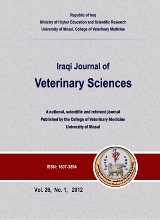Abstract
We aimed to evaluate the accuracy of early fetal sexing by sonography in nanny goats during three periods of gestation and their correlation with the number of fetuses. A total of 50 pregnant nanny goats were included in this study. The B mode of real-time scanner with 3.5-5 MHz transabdominal transducer was used to identify the fetal external genital organs and to evaluate the relative placement of genital tubercle (G.T.) within three different periods were the first period at 45-55 days of pregnancy, the second period at 55-56 days of pregnancy, and the third period at 65-75 days of pregnancy. The result showed that, in the signal fetus cases, the accuracy of fetal sexing was more accurate in the second period of pregnancy (62.5%) than that recorded in the first (56.5%) and third (40%) periods of pregnancy. The results in twine fetus cases showed that the accuracy of fetal sexing was more accurate in the first period of pregnancy (34.7%) than that recorded in the second (27%) and third (20%) periods of pregnancy. The results also showed that, in triple fetus cases, the accuracy of fetal sexing was more accurate in the 1st period of pregnancy (26%) than that recorded in the second (15.4%) and third (6.7%) periods of pregnancy. The results of the fetal sex determination showed that a total of 15 male fetuses were accurately detected, with three fetuses wrongly detected. Similarly, a total of 11 female fetuses were accurately diagnosed, and four fetuses were incorrectly detected. The sensitivity of fetal sex determination was 78.94%, and the gender detection accuracy, sensitivity, specificity, positive predictive value, and negative predictive value were 78.78, 78.57, 83.33, and 73.33%, respectively. We conclude that the transabdominal transducer at B mode used in the second period (55-56 days) of pregnancy was highly accurate for early fetal sex determination. Also, it is the best way to determine the number of fetuses in small ruminants.
Keywords
Fetal sexing
Goat
Ultrasonographic
Abstract
هدفنا إلى تقييم دقة تحديد جنس الجنين المبكر باستخدام الموجات فوق الصوتية في إناث الماعز خلال ثلاث فترات من الحمل وارتباطها بعدد الأجنة. وقد تم تضمين ما مجموعه 50 من الماعز الحامل في هذه الدراسة. تم استخدام الوضع بيتا للماسح الضوئي في الوقت الحقيقي مع محول عبر البطن 3.5-5 ميجا هرتز لتحديد الأعضاء التناسلية الخارجية للجنين وتقييم الوضع النسبي للدرنة التناسلية، ضمن ثلاث فترات مختلفة كانت الفترة الأولى عند 45-55 يوما من الحمل، والفترة الثانية عند 55-56 يوما من الحمل، والفترة الثالثة عند 65-75 يوما من الحمل. أظهرت النتيجة أنه في حالات الجنين الإشارة، كانت دقة تحديد جنس الجنين أكثر دقة في الفترة الثانية من الحمل (62.5٪) من تلك المسجلة في الفترتين الأولى (56.5٪) والثالثة (40٪) من الحمل. بينما أظهرت النتائج في حالات الأجنة الخيطية أن دقة تحديد جنس الجنين كانت أكثر دقة في الفترة الأولى من الحمل (34.7٪) من تلك المسجلة في الفترتين الثانية (27٪) والثالثة (20٪) من الحمل. وأظهرت النتائج أيضا أنه في حالات الأجنة الثلاثية، كانت دقة تحديد جنس الجنين أكثر دقة في الفترة الأولى من الحمل (26٪) من تلك المسجلة في الفترتين الثانية (15.4٪) والثالثة (6.7٪) من الحمل. أظهرت نتائج تحديد جنس الجنين أنه تم اكتشاف إجمالي 15 جنينا ذكرا بدقة مع اكتشاف ثلاثة أجنة بشكل خاطئ. وبالمثل، تم تشخيص إجمالي 11 جنينا أنثى بدقة مع اكتشاف أربعة أجنة بشكل غير صحيح. كانت حساسية تحديد جنس الجنين 78.94٪، وكانت دقة تحديد الجنس والحساسية والنوعية والقيمة التنبؤية الإيجابية والقيمة التنبؤية السلبية 78.78 و 78.57 و 83.33 و 73.33٪ على التوالي. نستنتج أن جهاز الاستشعار عبر البطن في الوضع بيتا المستخدم في الفترة الثانية (55-56 يوما) من الحمل كان دقيقا للغاية لتحديد جنس الجنين في وقت مبكر، كما أنه الأفضل في تحديد عدد الأجنة في المجترات الصغيرة.
